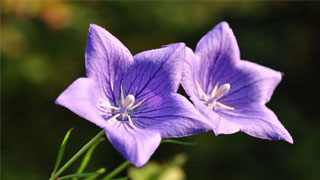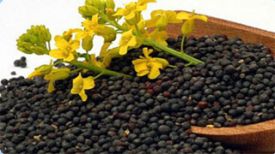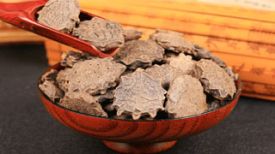
1. Alias
Stem grass, ginseng, bitter bellflower, white medicine, Liru.
2. Plant morphology
Perennial herb with white milk. The main root is spindle shaped and has few branches. The stem is 30-120 centimeters tall, hairless, usually unbranched or slightly branched at the top. Leaves 3-4 whorls, opposite or alternate, with no or very short stalks, ovate to lanceolate in shape, pointed at the top, serrated at the edges, wedge-shaped at the base, and covered with white powder below. 1 to several flowers, solitary stem apex or integrated sparse raceme inflorescence, calyx bell shaped, 5 lobes, corolla broadly bell shaped, diameter 4-6 cm, blue or blue purple, 5 lobes, triangular, 5 stamens, flower silk base widened, densely covered with fine hairs, ovary lower, style 5-lobed. Capsule.
3. Origin distribution
Born on mountain grassy slopes and forest edges. It is distributed and cultivated in various provinces and regions in the north and south.
4. Harvesting and processing
Excavate in spring and autumn, with autumn excavators having better quality. The traditional processing method is to scrape off the cork with a bowl or bamboo knife, and then dry it in the sun. In recent years, some regions have experimented with not scraping the skin, washing the soil and drying it in the sun, or slicing it in the production area and drying it in the sun. This method can save labor, but the appearance of the medicinal herbs is slightly affected.
5. Characteristics of medicinal herbs
Cylindrical or spindle shaped, slightly twisted, occasionally branched, 6-25 cm long, 0.5-2.5 cm in diameter. The surface is gray white or light yellow white, and there are crescent shaped stem scars on the upper rhizome (reed head); There are horizontal stripes on the roots, irregular longitudinal wrinkles and grooves throughout, and scars resembling transverse pores. Hard and brittle in texture, easy to break, with slightly uneven fracture surface and visible radial cracks. The skin is white in color, with obvious layer rings, and the wood is light yellow. Qi is faint, with a slightly sweet taste followed by a slight bitterness.
6. Sexual Taste Returning to the Classics
Flat in nature, bitter and pungent in taste. Return to the lung meridian.
7. Effect and Function
Promote lung function, eliminate phlegm, clear throat and discharge pus. It belongs to the category of clearing phlegm, relieving cough, and relieving asthma drugs.
8. Clinical application
Use 3-9 grams to treat cough, phlegm accumulation, chest and diaphragm tightness, sore throat, hoarse voice, and pulmonary tuberculosis with pus discharge. Treating lung abscess: 1 part of Campanula grandiflorum, 2 parts of Licorice, decoct in water and take orally. Oral administration of crude saponins from Platycodon grandiflorum has anti-inflammatory, sedative, analgesic, antipyretic, smooth muscle relaxing, and preventive and therapeutic effects on digestive ulcers.
9. Pharmacological research
The roots, stems, leaves, flowers, and fruits of Platycodon grandiflorus have significant expectorant effects. Extracts and saponins of Platycodon grandiflorus can be injected intraperitoneally into rats or guinea pigs to relieve cough; Toxicity: The LDso for oral administration to mice is 24 g/kg, and the minimum lethal dose for subcutaneous injection of saponins is 770 mg/kg. Saponin hemolysis, only for oral administration. Has anti-inflammatory, anti ulcer, and vasodilatory effects; Can slow down heart rate, suppress respiration, and weaken atrial contractility; It has the effects of lowering blood sugar, sedation and analgesia, lowering body temperature, lowering cholesterol, anti edema, and diuresis.
10. Chemical composition
Containing various triterpenoid polysaccharide saponins: Platycodon grandiflorus saponins A and C, Polygala tenuifolia saponins A and C. In addition, the roots also contain a large amount of Platycodon grandiflorus polysaccharides composed of fructose, steroids, α - spinach sterols, etc. The content of total saponins in Platycodon grandiflorum was highest at 10.17% during the greening period and lowest at 4.19% during the withering period. In addition, it contains saponins D, D2, D3, 2-O-acetyl saponins from Platycodon grandiflorus, apigenin, luteolin, methyl coumarinic acid-A methyl ester, coumaric acid A, coumaric acid B, coumaric acid C, etc.
11. Usage taboos
Individuals with chronic cough and coughing up blood due to Yin deficiency are prohibited from taking it; People with weak spleen and stomach should take it with caution. Excessive oral intake can cause nausea and vomiting.
12. Compatibility prescription
① To treat wind heat, cough, phlegm, and sore throat: 9g of Campanula, 15g of Mulberry Leaves, 12g of Chrysanthemums, 8g of Almonds, and 9g of Licorice. Boil it in water. (Qingdao Herbal Medicine Handbook)
② Treatment of lung abscess and vomiting blood: 9g of Campanula grandiflorum, 12g of winter melon seeds, 15g of Coix seed, 30g of reed roots, and 30g of honeysuckle. Boil it in water. (Qingdao Herbal Medicine Handbook)
③ Treatment for nosebleeds: Take a square inch dagger in water and take it four or five times a day. (From "Qian Jin Yao Fang")
④ Treating tooth decay: equal parts of Campanula and Fennel. Burn and apply it. (Hygiene Easy Recipe)
⊙ The content of the article is for clinical reference only. Non TCM professionals are not allowed to test drugs.


